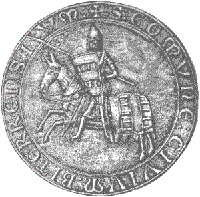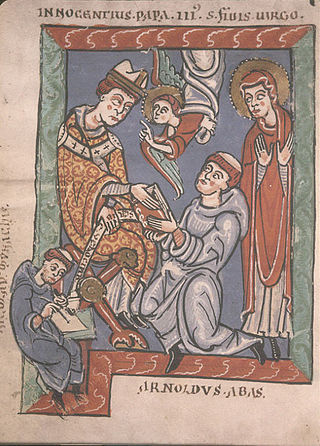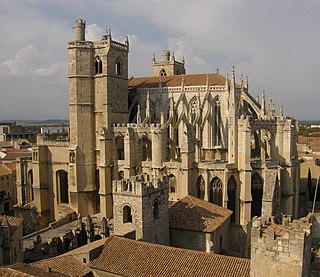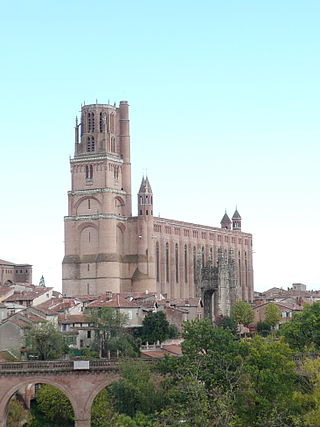Catharism was a Christian dualist or Gnostic movement between the 12th and 14th centuries which thrived in Southern Europe, particularly in northern Italy and southern France. Followers were described as Cathars and referred to themselves as Good Christians; in modern times, they are mainly remembered for a prolonged period of religious persecution by the Catholic Church, which did not recognize their unorthodox Christianity.

The Albigensian Crusade or the Cathar Crusade was a military and ideological campaign initiated by Pope Innocent III to eliminate Catharism in Languedoc, southern France. The Crusade was prosecuted primarily by the French crown and promptly took on a political aspect. It resulted in the significant reduction of practicing Cathars and a realignment of the County of Toulouse with the French crown. The distinct regional culture of Languedoc was also diminished.

The Trencavel was an important noble family in Languedoc between the 10th and 13th centuries. The name "Trencavel" began as a nickname and later became the family's surname. The name may derive from the Occitan words for "Nutcracker". The name was traditionally restricted in actual use only to those family members named Raymond, but the last Trencavel viscount, Raymond II, preferred the surname over his given name and adopted it for his charters.

Raymond VI was Count of Toulouse and Marquis of Provence from 1194 to 1222. He was also Count of Melgueil from 1173 to 1190.

Raymond Roger Trencavel was a member of the noble Trencavel family. He was viscount of Béziers and Albi, and viscount of Carcassonne and the Razès.

Fontfroide Abbey is a former Cistercian monastery in France, situated 15 kilometers south-west of Narbonne near to the Spanish border.

Pierre de Castelnau, French ecclesiastic, made papal legate in 1199 to address the Cathar heresy, he was subsequently murdered in 1208. Following his death Pope Innocent III beatified him by papal order, excommunicated Count Raymond VI of Toulouse, and declared the Albigensian crusade.
Ermengarde, was a viscountess of Narbonne from 1134 to 1192. She was the daughter of Aimery II of Narbonne and his first wife, also named Ermengarde.

Arnaud Amalric was a Cistercian abbot who played a prominent role in the Albigensian Crusade. It is reported that prior to the massacre of Béziers, Amalric, when asked how to distinguish Cathars from Catholics, responded, "Kill them [all], for God knows which are His own."

Henry of Marcy, or Henri de Marsiac, was a Cistercian abbot, first of Hautecombe in Savoy (1160–1177), and then of Clairvaux, from 1177 until 1179. He was created Cardinal Bishop of Albano by Pope Alexander III at the Third Lateran Council in 1179.
Olivier de Termes was a knight from the southern French region of Termes, Aude. He was raised as a Cathar but eventually converted to Catholicism in a move that would help restore peace to his homeland following the ravages of the Albigensian Crusade.

The former Catholic diocese of Narbonne existed from early Christian times until the French Revolution. It was an archdiocese, with its see at Narbonne, from the year 445, and its influence ran over much of south-western France and into Catalonia.
Roger II Trencavel was the Viscount of Carcassonne, Béziers, Razès, and Albi from 1167 or 1171 until his death. Until 1177 he used the title proconsul, usually as proconsul de Bitteris, but he abandoned the usage when he became a vassal of the Crown of Aragon. His government of his lands was characterised by increasing complexity, such as the development of the offices of seneschal and sub-vicar, but his later years are characterised by financial troubles and a "general malaise" perhaps brought about by his poor relations with the Church hierarchy in light of his favourable attitude towards Catharism.

Raymond II Trencavel was the last ruler of the branch of the Trencavel viscounts of Béziers. His entire life was occupied by efforts to reverse the downfall the Trencavel had experienced during the Albigensian Crusade, but he ultimately failed.
Raymond I Trencavel was the Viscount of Agde and Béziers from 1130 and Viscount of Albi, Carcassonne, and Razès from 1150. He was a member of the Trencavel family, ruling the lands of the elder branch.

The Roman Catholic Archdiocese of Albi (–Castres–Lavaur), usually referred to simply as the Archdiocese of Albi, is a non-metropolitan archdiocese of the Latin Church of the Catholic Church in southern France. The archdiocese comprises the whole of the department of Tarn, and has itself been suffragan, since the 2002 provinces reform, to the Archdiocese of Toulouse, a metropolitan archdiocese.
Bernard Ato VI was the posthumous son and successor of Bernard Ato V, Viscount of Nîmes and Agde. He reigned from 1163 until 1214, when he surrendered his fiefs to Simon de Montfort, Earl of Leicester and leader of the Albigensian Crusade. Bernard Ato was not connected with Catharism nor were his lands, but his relationship to Raymond Roger Trencavel may have marked him off as an enemy of the Crusade by default, for he was a Trencavel, though he did not carry that name.
The Liber instrumentorum vicecomitalium, sometimes called the Trencavel Cartulary (CT) or Cartulaire de Foix, is a high medieval cartulary commissioned by the Trencavel family. It preserves either 585 or 616–7 charters, the earliest of which dates to 1028 and the latest to 1214. The charters preserve a record of important feudal customs relating to the lands of the Trencavel, namely Albi, Agde, Béziers, Carcassonne, Nîmes, and Razès, all of which—save Carcassonne, which was a county—were viscounties, hence the cartulary's name. It is preserved in a twelfth-century manuscript, now kept with the Société Archéologique de Montpellier, where it is MS 10.

The siege of Minerve was a military engagement which took place in June and July 1210 during the Albigensian Crusade in the town of Minerve in southern France. It was undertaken by the Catholic Crusaders against the Cathars in southern France, who were regarded as a heretical sect. The Crusaders, led by French nobleman Simon de Montfort, besieged and captured the town. The Crusaders allowed the soldiers defending the town, Catholics, and any Cathars who had not yet reached the status of perfect to go free. Three Cathar perfects who repented were pardoned, but 140 others who refused to do so were burnt at the stake.
Aimery I of Narbonne, son of Bernard Berenger of Narbonne and Foy of Rouergue. He was viscount of Narbonne 1071 until his death in the Holy Land in 1106.